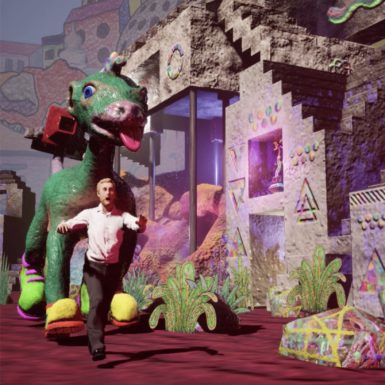[ad_1]

Jeremy Couillard, Self Portrait As a Dingus (still from video work), 2019.
COURTESY THE ARTIST AND DAATA EDITIONS
Over the past few years, Instagram has become a potent tool for dealers and artists offering artworks for sale. Now a museum is using the app as an exhibition site.
Tomorrow, the Bass Museum of Art in Miami Beach will open a show of digital art, titled “Joyous Dystopia,” with support from the John S. and James L. Knight Foundation’s Prototype Fund, on a dedicated Instagram account, @TheBassSquared. New and existing works by artists Bob Bicknell-Knight, Jeremy Couillard, Keren Cytter, Elliot Dodd, Anaïs Duplan, Rosie McGinn, Eva Papamargariti, and Scott Reeder will included in the show.
“Joyous Dystopia” is curated by David Gryn, who founded Daata Editions, an online platform that commissions and exhibits digital and new media works. Each week of the exhibition will focus on a different artist, and their pieces will be archived on Daata Editions at the end of the show’s run.
Gryn, who has previously worked as a curator of the film and sound program at Art Basel in Miami Beach, told ARTnews that the exhibition includes “artists who make a twist on their daily or regular use of Instagram, or their artworks make commentary on our daily lives or daily use of social media in some way.”
He added that the the project represents “another way of getting people to connect with those artists.”
Depending on the nature and length of their works, artists in the exhibition will also make use of the social media platform’s extra features, with videos longer than one minute posted to Instagram TV.
According to Bass curator Leilani Lynch, “Joyous Dystopia” is a test run for future digital initiatives by the museum, though there are not yet concrete plans for what they will entail. She said that the exhibition on Instagram is the result of conversations about the ways in which “technology be used to enhance a museum experience, what it can do, and what we need it to do, without creating something that could be seen as unnecessary.”
“We came full circle and ended on something that is actually quite simple but at the end of the day is about engaging our audiences in a way that is native to them, through their phones,” Lynch said in a phone interview. She added that the shape of future digital endeavors depend on how people interact with the prototype.
“We’ll see how it goes,” she said. “It’s been a privilege to experiment in this way.”
[ad_2]
Source link

